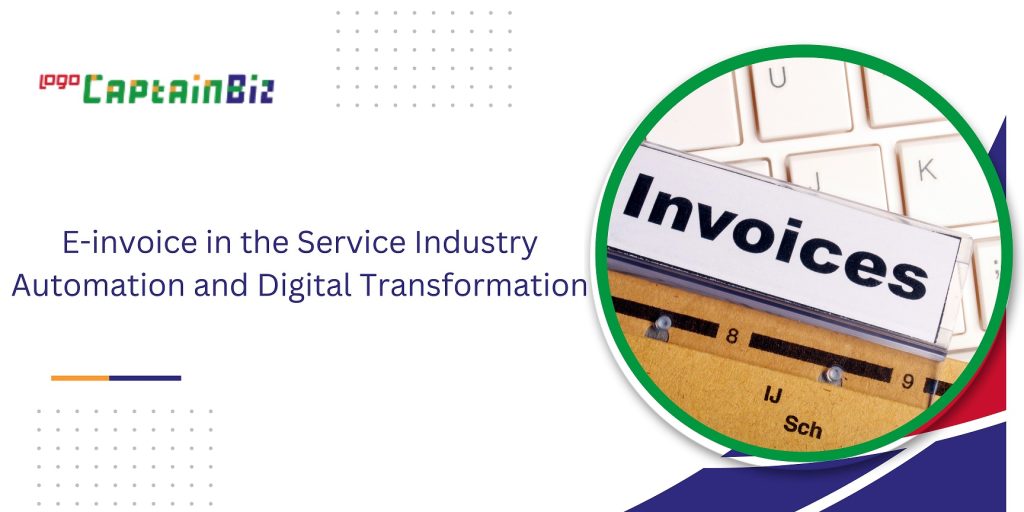E-invoice is not a novel concept. The EDI-Electronic data interface was used to create the first electronic invoice approximately 30 years ago, and since then, its use has increased. According to a survey by Zion Market Research, the global market size is expected to grow to almost $20 million by 2026.
With the advancement of technology, E-invoice in the service industry has become more powerful, allowing companies to expedite and secure the payment process. Simultaneously, the solutions are becoming more widely applicable and efficient, offering businesses advantages such as reduced expenses and enhanced cash flow.
How does an E-invoice Operate?
To create an e-invoice, you need an electronic device or software to send data in real time for each generated e-invoice to the tax administration system.
The buyer electronically acknowledges and signs the invoice when you provide them with an electronic version. This will start the payment process, which you and the buyer may monitor.
Depending on your business’s requirements, you can begin an automatic procedure that instantly updates your accounts receivable system or send the signed document to your customer as a PDF file.
Electronic invoicing is offered for many web service endpoints. Several parameterized web service integrations tailored to individual countries or configurable web service integrations can be used. By employing several configuration versions, different endpoints can be specified for the same web services and APIs.
E-invoicing can simplify your business operations, but it must take something other than tax paperwork. You might have to send your customers an invoice that includes all relevant tax information, depending on where you live. For providers of digital invoices, the procedure is different. While some providers will automatically have the necessary tax information for your invoice, others will ask you to submit it explicitly.
Invoice Automation: What is it?
“Invoice automation” describes substituting digital solutions, usually based on Electronic Data Interchange (EDI), for manual operations.Every stage of invoice administration, from the moment an invoice is received until the payment is processed, can be supported by automation.
In the absence of automation, invoicing is susceptible to human error. Processing invoices by hand causes costly delays, duplications, and inaccurate data entry.
What are the Benefits of Using E-invoice in the Service Industry?
E-invoice in the service industry has several advantages for clients and service providers. The following are a few benefits of sending bills electronically:
Process Automation
Like any paper-based process, traditional invoicing is labour-intensive and prone to human mistakes, which drives costs and lengthens business processing lifecycles. Businesses gain a competitive edge from process automation. Employees save time by not having to enter data because ERP systems automatically generate e-invoices manually.
Employees can spend more time on higher-value work by eliminating the tedious, time-consuming document handling and distribution tasks. Furthermore, the possibility of human error is significantly decreased.
Money Savings
Businesses can save costs by using e-invoicing, eliminating the need for invoice printing, shipping, and physical storage. It can be expensive to send invoices, especially for companies that get many of them.
However, e-invoicing enables businesses to save costs by doing away with the requirement for paper records and speeding up the invoice processing process. Businesses can invest in other value-added operations with the substantial cost reductions that result from this.
Shorter Cycle Time for Invoices
E-invoicing improves cash flow since it requires less time to receive and pay invoices. Reduced days between the time an invoice is issued and the time it is delivered is referred to as a shorter cycle time. Businesses receive speedier payment when they facilitate their clients’ e-invoicing.
Quicker payments improve cash flow for the seller while providing the buyer with potential early payment discounts and a reduction in late penalties. When e-invoicing is used instead of traditional paper-based invoicing, B2B payments can be made much faster.
Improved Cash Flow Control
With real-time access to their accounts receivable, firms may better manage their cash flow thanks to e-invoicing. Companies who invoice their customers using traditional techniques may not receive payment for weeks or even months.
Using e-invoicing to track payments and enhance cash flow management helps businesses make educated decisions and seize new possibilities. It also enables businesses to plan for future expenses and investments, guaranteeing they have the funds to support their expansion objectives.
Better Security
Electronic signature systems ensure the authenticity and provenance of e-invoices, which are transmitted via private networks or protocols. Stricter digital security measures are becoming increasingly necessary for all firms, particularly those dealing with sensitive or personal data.
E-invoices are encrypted during the whole distribution process with the correct service provider, which is a secure step for your business as well as your clients and vendors.
Enhanced Sustainability
Electronic invoicing can reduce the environmental impact of an organisation by eliminating the need for paper invoices. By cutting back on waste, carbon emissions, and paper use, it improves the sustainability of the business model.
E-invoicing helps companies reduce their carbon footprint and the overall environmental effect of their operations by reducing transportation requirements.
Deals for Suppliers
Incentives are frequently offered by suppliers for on-time payments, and late payments may result in fines. When customers use e-invoicing to settle their invoices, they can do so more quickly and benefit from early payment incentives suppliers offer.
Enhanced Compliance
Automation facilitates firms’ adherence to legal requirements, regulatory frameworks, and industry norms. Additionally, automated systems lessen the possibility of fines for noncompliance.
How to Automate and Digitally Transform Your Service Business with E-invoice?

E-invoicing is a helpful tool for businesses. It makes creating, handling, and organising invoices easier. Its ability to expedite invoicing, saving both time and money, is one crucial advantage. Let’s investigate this further.
Effective Data Gathering
Advanced technologies are used by e-invoicing solutions to immediately extract invoice data from electronic forms like Word or PDF files. The system is far more accurate since it cleverly gathers important invoice data, such as vendor details, line items, quantities, prices, and totals.
Seamless Coordination
The requirement for manual data entry into numerous systems is removed when e-invoicing systems are easily integrated with pre-existing financial management or enterprise resource planning (ERP) software. This facilitates the easy transfer of invoice data. This is not only faster, but it also reduces disparities in data, streamlines duties related to reconciliation, and guarantees that all parties are making decisions based on the same information.
Integrating the systems frees up time and resources for other strategic tasks that bring more value, especially for accounts payable. Your workers feel more appreciated, become more involved, and contribute to the company’s expansion—especially the accounts payable team.
Enhanced Reporting and Visibility
By allowing businesses to track the status of their invoices, monitor when payments are due, and provide comprehensive reports, e-invoicing saves them a great deal of money and effort while providing real-time access to the invoicing process.
By using dashboards and analytics, organisations can obtain real-time insights into Key Performance Indicators (KPIs), such as invoice volumes, payment trends, and processing timeframes.
The Power of E-Invoice in B2C Transactions
CaptainBiz – Popular Electronic Invoicing System
CaptainBiz is a comprehensive software solution for inventory management, business bookkeeping, and billing. You can download sales records (compatible with Tally) or GST reports for monthly tax filing, send invoices via email or WhatsApp, track inventory promptly, and keep track of payments owed to you.
Manufacturers, distributors, wholesalers, dealers, retailers, and service-oriented enterprises are the target market for CaptainBiz. This software facilitates speedy invoicing, inventory management, payment tracking, cash and bank transaction monitoring, Tally-compatible report exporting, and creating GST reports ready for filing (for GST-registered enterprises). With CaptainBiz, rediscover the pleasure of conducting business without stress.
Conclusion
In summary, incorporating technology into the invoicing process is an essential first step towards a digital and financial revolution. The Order-to-cash cycle is streamlined, and cash flow management is enhanced when manual invoicing is replaced with electronic invoicing, increasing operational performance.
Digital transformation to electronic invoicing benefits businesses as well as their clients. Using digital invoicing demonstrates how technology can transform current business procedures.
We at CaptainBiz emphasise honesty, openness, and outstanding output. We offer straightforward solutions to expanding businesses and start-ups, and we assist with their appropriate implementation to achieve the intended outcomes.
FAQs
-
What is e-invoice, and what are the advantages for the service sector?
The electronic exchange of invoice papers between companies and their clients is called e-invoicing. By decreasing human data entry, increasing accuracy, and simplifying financial procedures, it helps the service sector.
-
What is e-invoice automation?
The act of electronically creating, sending, and processing bills is known as “e-invoice automation,” which helps organisations streamline their invoicing processes by doing away with manual tasks. It facilitates more efficient, time-saving, and error-free financial transactions.
-
What distinguishes a digital invoice from an electronic invoice?
A digital invoice is an invoice that exists in an entirely electronic format and may contain several data types, not always resembling a regular paper invoice. An e-invoice is an electronic counterpart of a traditional paper invoice.
-
In what ways may automation help the service industry’s billing process run more smoothly?
Automation can aid in generating, transmitting, and processing bills, minimising errors and expediting the payment cycle. It also makes real-time reporting and tracking possible.
-
What financial benefits come with automation and e-invoicing?
By lowering the cost of paper and postage, eliminating errors, and increasing operational efficiency, e-invoicing and automation can result in cost savings.
-
What are the most important characteristics when choosing an e-invoicing programme or service for the service sector?
The ability to create, transport, store, integrate with accounting systems, comply with local laws, and generate reports are among the crucial characteristics.
-
Is there a way to automate invoices?
Automated software creates a record using the purchase order on the invoice. The programme may add the invoice to a general ledger account without a purchase order. Machine learning is used by specific software programs to match an invoice to the appropriate account.
-
How does Invoice automation work?
With software and digital communication channels, e-invoice automation streamlines the invoicing process by eliminating the need for paper-based invoices and generating, transmitting, and processing invoices electronically. Standardised formats and automated procedures are frequently used to increase productivity and lower invoicing error rates.
-
How can service providers manage their working capital and cash flow better using e-invoicing?
E-invoicing can expedite payment processing, reducing the time business takes to get paid and enhancing cash flow. Additionally, it offers improved visibility into unpaid bills.
-
What are the best ways for the service sector to embrace digital transformation and switch to electronic invoicing?
Assessing the present invoicing procedures, choosing the best e-invoicing software, educating personnel, and phasing in the switch to electronic invoicing are all examples of best practices.

